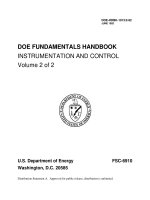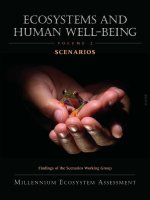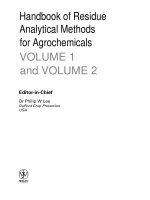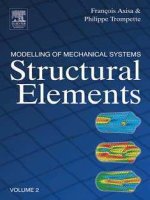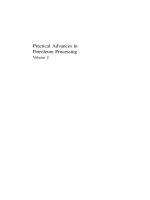Volume 2 wind energy 2 01 – wind energy – introduction
Bạn đang xem bản rút gọn của tài liệu. Xem và tải ngay bản đầy đủ của tài liệu tại đây (1.2 MB, 10 trang )
2.01
Wind Energy – Introduction
JK Kaldellis, Technological Education Institute of Piraeus, Athens, Greece
© 2012 Elsevier Ltd. All rights reserved.
2.01.1
Introduction
2.01.2
Pros and Cons of Wind Energy
2.01.3
Brief Content Presentation
2.01.4
Conclusions
References
Further Reading
Relevant Websites
Glossary
Aeolus According to Greek mythology, Aeolus was the
ruler of winds.
Calm spell The period of time during which wind speed
takes values lower than a predefined value. Normally calm
spells are considered to occur when the appearing wind
speed is lower than 2 ms−1, although in the case of wind
turbines, calm spells may be considered as corresponding
to the periods that wind speed is lower than the wind
speed required for the machine to start operating.
Capacity factor The capacity factor of a wind turbine refers
to the ratio of actual energy production of the machine for
a given time period to the respective potential energy
production of the same machine if it had operated at its
rated power for the entire time period.
Energy pay-back period The period of time required for
the entire amount of energy embedded in a system
(during its life span) to be compensated by the system's
energy production.
Feed-in tariff Feed in tariff refers to a policy mechanism
developed for the support of renewable energy
technologies, through the award of a certain payment per
kWh for electricity produced by a renewable resource and
fed into the grid. Feed in tariffs may vary on the basis of
technology, geographical location and installation site.
Life-cycle Life-cycle refers to the period of time capturing
all stages involved in a project, including energy projects
as well. Regarding an energy plant (e.g., a wind farm), lifecycle concerns the stages of equipment manufacturing,
transportation, installation, operation and
decommissioning.
1
3
5
8
9
10
10
Neural network The term actually refers to artificial neural
networks composed by artificial interconnected neurons
which are used to mimic properties of biological neurons,
in order to solve artificial intelligence problems.
R&D The term is used to describe research and
development, and refers to creative work undertaken on a
systematic basis in order to increase the stock of
knowledge, and the use of this stock of knowledge to
devise new applications.
Technical availability Technical availability is configured
by the hours of operation of a given wind turbine or a
given wind farm, by subtracting the time period that the
machine is kept out of operation due to, e.g., scheduled
maintenance, unforeseen faults of the machine, etc.
Wind energy The kinetic energy carried by a wind stream
of certain characteristics (e.g., wind speed and air density).
Wind farm-wind park A group of wind turbines installed
within the boundaries of a given area (either onshore or
offshore) for the purpose of massive power generation.
Wind hybrid stand-alone system A power configuration
that is used for the electrification of consumers that are
not interconnected to an electricity grid and that combines
two or more energy conversion systems – with one of
them being a wind turbine (or a wind farm) – with an
energy storage device.
Wind power The conversion of wind energy to useful
forms of energy, i.e. mechanical work.
Wind turbine A man-made machine used to exploit the
kinetic energy of wind so as to produce wind power in the
form of electricity.
2.01.1 Introduction
Ever since the early days of mankind, wind was viewed as one of the most arresting natural phenomena. In fact, according to Greek
mythology, humans worshipped the wind god Aeolus, who along with his eight assisting gods, that is, the so-called Anemoi, each
assigned with one wind direction (Boreas (N), Kaikias (NE), Eurus (E), Apeliotes (SE), Notus (S), Livas (SW), Zephyrus (W), and
Skiron (NW)) (Figure 1), was considered as the ruler of the winds, thus underlining the importance of wind energy for the economic
and production activities during even this early historic period.
In this context, wind energy was initially exploited for the navigation of ships (Figure 2), while further, the first relatively simple
applications of wind energy exploitation for the production of mechanical work appeared. At the same time of course, in order for
their constantly increasing needs to be satisfied, people had to exploit other energy sources as well. However, despite the existence of
alternative energy sources, wind machines were found to comprise a rather useful solution for the grinding of grains and other
Comprehensive Renewable Energy, Volume 2
doi:10.1016/B978-0-08-087872-0.00201-8
1
2
Wind Energy – Introduction
Figure 1 The tower of winds, situated in Athens (shown are Boreas and Skiron).
Figure 2 Greek stamp demonstrating the Argo sailing ship.
Figure 3 Aspects of a medieval-type windmill for grinding grain and an American-type windmill used for water pumping.
production activities up until Medieval times [1], while a great number of multiblade wind machines installed mainly in the United
States during the nineteenth century were used for water pumping purposes [2] (Figure 3).
Although acknowledging the importance of these early stages of wind energy history, it is believed that true and actual interest in
wind energy grew during and after the end of the two world wars and wind energy was established after the consecutive energy crises
between 1970 and 1980 [3]. More specifically, in the early 1980s, contemporary power generating wind turbines of 15–100 kW first
Wind Energy – Introduction
3
250 m
180 m
150 m
125 m
110 m
15 m
1980 1985
50 m
40 m
20 m
1990
1995
2000
2005
2010
2015
2020
Figure 4 Time evolution of contemporary wind turbine size. Based on data from European Wind Energy Association (2009) Wind energy the facts,
technology, wind turbine technology. (accessed September 2011) [4].
appeared, followed by machines of somewhat greater power of around 300 kW. Accordingly, up until the mid-1990s, the rated
power of wind turbines was in the order of 600–1000 kW, while nowadays, the market of modern wind turbines is dominated by
multimegawatt machines, with rotor diameters even exceeding 150 m (Figure 4) [4]. In this context, current short-term realistic
targets in terms of rated power are elevated to machines of 10 MW, destined mainly to serve offshore wind energy applications [5, 6],
although future innovative concepts will increase machine capacity even more [7].
As a result of these constant developments, the global installed capacity of wind turbines has nowadays exceeded 200 GW
(Figure 5) [8], with the contribution of wind energy to the local electrical energy balance of certain countries even exceeding 10%
(Figure 6) [9]. At the same time, based on future plans and announcements made by the authorities of the most developed
countries, wind energy applications are expected to develop even further, with a target of 1000 GW installed wind power to be
achieved by 2030 (Figure 7) [10]. Considering the situation encountered so far, efforts are undertaken in this introductory chapter
of the encyclopedia in order to first present the most important pros and cons of wind energy and to then provide a short summary
of the following 21 chapters comprising the wind energy volume.
2.01.2 Pros and Cons of Wind Energy
Wind energy, which is explicitly the exploitation of the kinetic energy of wind, has attracted the interest of people since the early days
of history. Note that the global wind potential is configured mainly by the absorbance of only a small proportion (∼0.2%) of the
incident solar energy on the various regions of the planet, which eventually leads to the development of climate.
Time evolution of global wind power capacity
500 000
Forecast
450 000
Installed capacity (MW)
400 000
350 000
300 000
250 000
200 000
150 000
100 000
50 000
15
14
20
13
20
12
20
11
20
10
20
09
20
08
20
07
20
06
20
05
20
04
20
03
20
02
20
01
20
00
20
99
20
98
19
97
19
19
19
96
0
Year
Figure 5 Time evolution and prediction of global wind power installed capacity. Based on data from Global Wind Energy Council (2011) Global wind
report 2010. (accessed September 2011) [8].
4
Wind Energy – Introduction
Contribution of wind energy to the electricity generation
of certain leading countries
20%
Denmark
Spain
Germany
Portugal
Contribution share
16%
12%
8%
4%
0%
1994
1997
2000
2003
2006
2009
Year
Figure 6 Wind energy contribution in the electrical energy balance of representative countries. Based on data from Energy Information Administration
(2011) International energy statistics. (accessed September 2011) [9].
Reference scenario of future regional wind energy
development in 2020 and 2030
400
Installed capacity (GW)
350
2020
2030
300
250
200
150
100
50
OECD Pacific
(incl. South
Korea)
Africa
Middle East
China
India
Dev. Asia
(excl. South
Korea)
Latin America
North America
Transition
economies
EU-27
0
Figure 7 Regional development of wind energy according to the reference scenario of the Global Wind Energy Council. Based on data from Global Wind
Energy Council (2011) Global wind power outlook 2010. (accessed September 2011) [10].
In this context, wind energy comprises a nonfinite renewable energy source with a vast potential that is, however, only partly
exploited by the currently available wind energy technology [11, 12]. In parallel, it should also be noted that wind potential is
distributed across the world, without of course neglecting the fact that in some areas, local wind potential may be of higher/lower
quality. Thus, as it may easily be concluded, the availability of wind energy throughout the planet contributes remarkably
in providing balanced development opportunities all over the world [13], regardless of the existence of other fossil fuel reserves
(e.g., oil, coal, natural gas, and uranium) distributed unevenly [14]. Finally, given also the fact that wind energy is normally of
higher quality in more remote and less inhabited/developed areas, efforts for exploiting the local wind potential contribute not only
to the increase of energy independence but also to the support of distributed generation patterns [15, 16] and the electrification of
isolated consumers [17, 18]. On the other hand, apart from its expansion to the most remote areas, wind energy has recently entered
the urban environment as well, with concepts of building integrated wind turbines aspiring to contribute remarkably to the future
electrification of urban consumers [19–21].
At the same time, given the severe environmental problems of our planet, exploitation of wind energy may be determined as an
environmentally friendly way of covering energy needs, with minimum, local-character environmental impacts involved [22, 23]
being at least two orders less severe than that caused by conventional energy sources such as nuclear, coal, and oil [24]. In addition,
Wind Energy – Introduction
5
installation and operation of wind parks may be considered as of low risk, with accidents recorded being minimum, while
additionally, the impacts of natural disasters (e.g., fires, floods, and earthquakes) are also not considerable in the inhabited
surroundings of operating wind farms. For this purpose, wind energy is established as a clean (green) energy source, which is
also determined by a rather low energy payback period of less than 1 year, reflecting the contribution of the respective technology to
sustainable development as well [25, 26].
On the other hand, wind energy is not always available, meaning that it is based on noncontrollable natural phenomena, which
are responsible for the so-called intermittency of wind energy production [27]. However, despite the stochastic nature of wind
energy, there are numerous advanced calculation tools that can provide reliable prediction of wind speeds [28–31], although due to
the fact that wind energy exploitation is limited within a specific range of wind speeds (usually between 3–4 and 25–30 m s−1), the
possibility of long-term periods during which no energy production is encountered (i.e., either calm spells or extreme wind speeds)
should also be considered. As a result, when considering wind energy, it is imperative to also consider a reserve energy source such as
backup conventional power stations, energy storage systems [32–36], and hybrid units [37–40], which can be used to complement
any energy deficit caused by the intermittency of the primary wind energy system. In addition, intense variation of the wind speed
may also cause severe impacts on the quality of the electricity produced (e.g., voltage and frequency issues) [41–44], which requires
installation of additional cost compensation mechanisms in order to provide consumers with the appropriate quality of electricity.
Finally, given the fact that the energy density of wind is relatively low, the per unit area maximum exploitation of wind energy by
contemporary wind turbines ranges mainly between 150 and 300 W m−2. This fact along with the technological status of modern
wind machines imposes the need to operate a significant number of large-scale wind turbines in order for sufficient energy
production to be achieved. For example, a modern wind turbine of 3 MW has a rotor diameter of around 100 m and a swept
area of around 8000 m2, while providing an annual energy production in the order of 7500 MWhe. Furthermore, due to the
considerable size of modern machines and the fact that they may operate in highly visible areas, the visual impact perception by the
local inhabitants found in the proximity of a given wind farm suggests one of the major issues concerning wind energy [45, 46].
Similarly, the issues of noise production and impacts on local ecosystems (mainly bird collision) caused by the operation of wind
farms are also of major importance [47–49]. In this context, it should be noted that although such issues should always be taken
into account when considering installation and operation of a new wind farm, they usually influence relatively restricted areas in
the surroundings of wind farms and are normally the subject of detailed and analytical studies carried out by wind energy
developers [50, 51].
Synopsizing, by considering the pros and cons of wind energy, which will be further analyzed and elaborated in the following
chapters, it is the opinion of the current volume’s editorial team that wind energy suggests a renewable, widely distributed, and
environmentally friendly energy source, applications of which are determined by high-quality technological standards and
contribute considerably to the satisfaction of constantly increasing energy needs and the protection of the environment. In this
context, it is expected that the development rate of such applications shall persist at high levels encountered so far, aiming to
contribute more than 15% to the planet’s electrical energy needs within the next 20 years.
2.01.3 Brief Content Presentation
Chapter 2.02 provides a thorough view of wind energy issues. A review of the past and current energy status on a global level is
first undertaken, analyzing in detail the major energy trends as well as the contribution of fossil fuels and renewable energy
sources. According to the existing official data, the current contribution of wind energy is rather limited, although increased
wind energy participation should be expected in the future fuel mix of our planet. In this context and through the determina
tion of the current wind power status and the evaluation of long-term wind energy developments, predictions concerning future
prospects of wind energy appear to be rather encouraging. Thus, Chapter 2.02 clarifies the present role and future prospects of
wind energy in the energy balance of the planet, giving at the same time a rather enlightening picture of the global energy
market.
Accordingly, an overview of wind energy history starting from ancient windmills and extending to contemporary modern
wind turbines is included in Chapter 2.03, with a scientific trip dating back 7000 years that is, to the use of sails to propel reed
boats in Mesopotamia, being the basis of this analysis. Subsequently, the most well-known windmills are described, while the
basic ideas and concepts used are also mentioned. Moreover, the major milestones in the progress of wind power applications
and the history of the main relevant organizations are presented, while finally, the major competing wind turbine
designs are briefly investigated, including the horizontal and vertical axis machines, the number of their blades (basically
two- vs. three-bladed ones), etc.
Chapter 2.04 is devoted to giving an overview of the methods used to estimate the wind energy potential, starting from resource
description and resulting in contemporary methods of forecasting. More precisely, the basic elements of wind potential evaluation
theory and the main measurement techniques are demonstrated. Also the most representative analytical and numerical models used
to accurately describe the wind potential of an area are presented, while the most widespread software tools used in order to
reproduce the wind resource atlas of an area are described. The chapter concludes with a brief description of the most reliable wind
potential forecasting methods, including artificial neural network models and Bayesian model averaging. Besides, the main scope of
the entire analysis is estimation of the expected wind energy yield of a wind park as well as scheduling of optimum wind energy
integration into an electrical network and implementation of the necessary system maintenance.
6
Wind Energy – Introduction
The scope of Chapter 2.05 is to describe the transition from ancient windmills to modern electricity generating wind
turbines, with special emphasis on underlining the significant changes that the wind energy conversion technology has
undergone. This is followed by a discussion of the basic principles governing the wind energy conversion process and a
classification of wind turbines, with every wind machine being categorized according to its special characteristics (e.g., number
of blades, axis orientation, and control type). Finally, the chapter concludes with an overview of the main components of
established wind turbines, while additional effort has been placed on giving a brief description of the time evolution of
commercial wind turbines.
In Chapter 2.06, a systematic study is carried out in order to present the main directions for the estimation of energy production
by contemporary wind turbines. For this purpose, wind potential principles with operational characteristics of contemporary wind
turbines are combined in order to calculate the corresponding mean power coefficient and the corresponding capacity factor. In this
context, the basic theoretical models used to describe the wind turbine output and the available wind potential are analyzed.
Furthermore, specific issues such as the reliability of calculations based on real measurements compared with pure analytical
equations, the impact of hub height on the corresponding energy yield, the wake effect, and the air density impact on the
corresponding energy yield are all considered, while subsequently, the impact of the technical availability on the wind turbines’
energy yield is also examined. Finally, the representative commercial wind turbines for various typical wind potential cases are
classified, providing at the same time detailed guidelines on the selection of the most appropriate wind turbine for a given wind site,
in order to ensure both maximum energy yield and optimum operation of the machine.
The contents of Chapter 2.07 include an overview of the basic principles applied during the design of a new wind park. In this
context, a general description of the issues that should be taken into consideration during the wind park design procedure is given,
including site selection, wind potential evaluation, wind turbine micrositing, array losses, infrastructure required, collaboration
with the local electrical network, social approval, and wind park output estimation. Selected representative case studies are briefly
analyzed, while special attention is given on presenting the basic installation issues of commercial wind turbines. This chapter
concludes with a brief presentation of some of the most characteristic wind parks in the world, including one of the biggest onshore
(Roscoe, Texas) and offshore (Thanet, UK) installations.
Chapter 2.08 focuses on providing an overview of the basic aerodynamic methods used to analyze contemporary wind turbines,
with regard to modeling and prediction of aerodynamic forces on the various parts of the machine, considering at the same time
that wind turbine aerodynamics is the main discipline for the design and construction of wind turbine blades. In this context, all
concepts, starting from the basic one-dimensional momentum theory up to the contemporary three-dimensional methods using
the complete Navier–Stokes equations, are briefly analyzed. Accordingly, the status of the most important research areas within the
aerodynamics of wind turbines, rotor wakes, and wind farms is presented, following which the optimization of wind turbine rotors
with respect to minimizing the cost of energy produced by wind turbines is described. Finally, an introduction to the prediction of
aerodynamic noise from wind turbine rotors is also provided.
Chapter 2.09 provides an introduction to loads for both onshore and offshore wind turbines with a focus on the respective windand wave-induced ones, so as to assess the structural integrity and power performance of wind turbines. Taking into consideration
the significant activity and the prospects of offshore wind energy, emphasis is placed on offshore applications as well. In this
context, the basic types of loads along with their sources are presented, including loads in the operational and survival conditions,
fault cases, controller actions, and response-induced forces. Several innovative concepts concerning huge onshore and offshore
turbines as well as floating turbines that require dynamic analysis and comprehensive load modeling are also examined, with
selected case studies for both fixed and floating wind turbines being provided.
Chapter 2.10 gives an overview of the main electrical parts of contemporary wind turbines along with their basic operational
principles. More specifically, power control, generators, power electronics, grid connection, and lightning protection are all
discussed in detail. In this context, the analysis is focused on the basic types of electrical generators (synchronous and induction
machines, constant-variable speed, etc.), yaw motors, and pitch control motors, while a brief presentation of the wind turbine
ancillary electrical equipment is included as well. Note that although the content of this chapter mainly concerns present-day
multimegawatt turbines, small machines are also taken into account. On top of that, a list of the most important manufacturers in
the field is included and some insight into the future outlook of the sector is provided.
Chapter 2.11 investigates the control systems of contemporary wind turbines, including an overview of basic principles and
representative types. Besides, a brief presentation of the dynamic control theory is included, along with an introduction on
monitoring and power production control systems. In this context, the power production control comprises the generator torque
control and the pitch control subsystems, the power electronics, and the grid connection. On the other hand, yaw control is also
discussed, while emphasis is placed on operating states and fault diagnosis, as well as on the fail-safe backup systems analysis.
Finally, the main sensor and actuator manufacturers of the field are briefly presented.
Chapter 2.12 mainly describes testing procedures of new wind turbines along with the up-to-now existing standardization
processes. Additionally, emphasis is placed on discussing the major safety issues as well as any manufacturing, installation, and
operational issues related to the safe operation of wind turbines, designating coherence between these elements. Accordingly, the
various international standards (mostly the International Electrotechnical Commission) related to design aspects for large and small
wind turbines onshore and offshore and testing of power performance, mechanical loads, acoustic noise, power quality, and safety
are described, while the various certification schemes are also examined. Finally, a presentation concerning the organizations
involved in the formal testing, standardization, and certification procedures for both existing and new wind turbines and wind parks
is included.
Wind Energy – Introduction
7
Chapter 2.13 gives an overview of the most important issues related with the design and implementation of a wind power
project. Actually, in this chapter, all stages of the project development process, in terms of what needs to be done and how to do it,
are described in detail. In this context, the main parameters affecting the design of a new wind park along with the basic practical
steps of the implementation of such a project are examined, with emphasis on infrastructure considerations as well as on financial
issues during the project design and implementation. Subsequently, environmental aspects and social approval of new power
stations are analyzed together with the experience from mitigating possible reactions in such projects. Finally, available information
concerning the operation and maintenance of wind parks is also provided, including condition and performance monitoring as well
as plant decommissioning and site restoration.
Chapter 2.14 presents offshore wind energy activity all over the world, providing a historical review from the very beginning of
offshore applications along with an overview and future trends of the technology employed. In addition, the basic concepts of
offshore wind farm design as well as issues concerning installation and maintenance activities are discussed. Accordingly, special
emphasis is placed on presenting the support structures and towers used in offshore wind parks, while finally the most important
economic, environmental, and social considerations during the development and operation of offshore wind farms are examined
in detail.
Chapter 2.15 reviews the generation costs concerning onshore and offshore wind parks, determines the relative importance of
turbine prices, slight costs, and other factors, and indicates how generation costs are influenced by the major economic parameters
(capital cost, inflation rate, etc.) and the depreciation period. Accordingly, additional parameters that should be taken into
consideration for a fair comparison between wind energy and fossil fuel electricity generation cost are also examined, for example,
external cost, embedded benefits, and extra balancing cost, while methods of valuing wind energy are also considered. Finally,
examples of ‘total cost estimates’ are discussed, taking into account most of the debits and credits associated with wind energy
applications. The chapter concludes with a discussion of published forecasts of future price trends.
Chapter 2.16 deals with the main social and environmental benefits from the introduction of wind energy in a given area, such
as reduction of carbon dioxide and air pollutants’ emissions, decrease in the import of fossil fuels, creation of new job positions, and
regional development. In addition, environmental concerns resulting from wind power plants, such as noise, visual impacts, and
possible disturbance of the wildlife are described. Accordingly, special attention is paid on offshore wind power plants since they
may impose distinct and in many cases quite different environmental impacts from onshore installations. Besides, another very
interesting issue investigated is the social acceptance and public attitude of wind energy, while finally methods for the reliable
assessment of impacts, mitigation measures, and future trends are also being discussed.
Chapter 2.17 examines the role of renewable energy within the context of global energy markets, investigating at the same time
the skepticism toward wind energy. In this context, the link between energy and economic development is considered, while special
emphasis is placed on the role of fossil fuels and nuclear energy. Accordingly, the opportunities of renewable energy sources and
more specifically of wind energy to largely contribute to the world energy market are discussed, underlining that economic
feasibility is the major obstacle for the wider participation of wind energy. Subsequently, the economics of wind energy are
investigated in view of the economic structure of electricity grids, while finally the costs that wind energy may impose on the rest of
the electricity generation systems are also examined, especially in case of large-scale wind energy integration.
Chapter 2.18 presents an overview of the opportunities and problems associated with the integration of wind energy into
electrical networks currently in operation or under development. More precisely, a description of wind energy integration require
ments and consequences that the particular characteristics of wind energy, namely its fair predictability (stochastic behavior) and
fluctuations of generated power, may induce into an electrical network is provided. Accordingly, distributed systems are presented
and the benefits of wind energy integration into common interconnected microgrids and stand-alone microgrids are described. This
is followed by a discussion of wind forecasting and economic issues, considering also future trends concerning significant wind
energy integration into existing electrical grids.
Chapter 2.19 introduces the reader to the definition and special features of wind-based stand-alone hybrid energy systems. The
introduction emphasizes on the basic characteristics of stand-alone and hybrid energy systems including also representative
application examples in different sectors. After a short reference to the historic development of wind-based stand-alone systems,
the contribution of wind energy in distributed generation is analyzed. The most common commercial system configurations of
stand-alone installations are discussed in detail through various case study results in order for the reader to obtain a comprehensive
view of the opportunities given by the different combinations. Furthermore, a short description of the energy storage systems
available is presented along with a short reference to the most well-known free software tools that are extensively used for the design
and optimization of hybrid energy systems.
Chapter 2.20 gives an overview of the wind power industry in the course of time along with the corresponding market
development, addressing at the same time key drivers and new trends. In this context, the galloping wind power
development noted during the past 15–20 years on a global scale is illustrated, emphasizing on the long-term annual
growth rate of almost 25%. Accordingly, the major wind energy markets are analyzed, including China, the United States,
Germany, and Spain. Finally, a brief presentation of the major wind power manufacturers along with their market share
time evolution is included.
In Chapter 2.21, a systematic study is carried out in order to present the main trends, prospects, and R&D directions of
wind turbine technology. For this purpose, investigation of the main technological developments throughout the entire period
of wind energy growth is undertaken, while emphasis is placed on recording the most important research efforts that have allowed
wind energy establishment. Accordingly, several research efforts remarkably financed during the previous years are acknowledged,
8
Wind Energy – Introduction
while simultaneously, major wind energy technological problems and the most challenging future R&D issues are discussed. The
chapter concludes by synopsizing the most important problems to be faced by the wind energy community at all levels in order to
ensure that growth trends encountered until today will not be limited in the years to follow.
The volume is integrated in Chapter 2.22 with the examination of representative wind power applications. In this context, one of
the most important applications analyzed is the desalination of seawater and/or brackish water, utilized in order to supply the
required quantities of freshwater to various areas of the planet facing water shortage. Furthermore, other significant applications of
wind energy, like the traditional and well-known application of wind-based water pumping and the more modern application of
power generation in remote telecommunication stations, are also briefly discussed. Additionally, emphasis is placed on the sizing
procedure of these systems as well as on their financial viability. Finally, selected examples of the most representative special wind
power applications along with their main technical characteristics are demonstrated as well.
2.01.4 Conclusions
Considering its status quo at the global scale, wind power can nowadays be perceived as one of the most mature and reliable energy
solutions, which is reflected by the constantly growing installed capacity, recently exceeding 200 GW. On the other hand, although
now suggesting an established power generation source, research efforts in the field of wind energy are still ongoing, with emphatic
targets set at both the national and international level configuring the future prospects of wind power applications. At the same
time, we are now arguably facing development of the fourth-generation wind machines, while also noticing multidirectional shifts,
for example, from onshore to offshore wind power applications, from large-scale rural wind farms to urban environment
small-scale wind machines destined to serve on-site domestic electrical loads, and from centralized wind energy generation to
distributed generation patterns involving wind-based stand-alone applications.
Within this constantly evolutionary environment in terms of technological trends, global wind power market facts also produce
consecutive changes of scene. In this context, according to the current situation, China is currently the leader in wind energy,
operating a total of ∼45 GW of wind power within its territory, followed by the United States (∼40 GW), Germany (∼27 GW), and
Spain (∼21 GW). Meanwhile, India with galloping rates of development during the recent years has installed a cumulative capacity
of more than 13 GW. Acknowledging the above, parallel development of different world regions noted reflects the relatively even
distribution of wind resources across the globe, nowadays extended to also capture the offshore wind potential.
In this context, the developing rates of offshore applications are even more encouraging, with regional plans, such as those of the
European Wind Energy Association, aiming at 600 TWhe produced by offshore wind energy by 2030. At the same time, according to
the reference scenario of the Global Wind Energy Council, the total installed capacity of wind power applications (both offshore
and onshore) by 2030 is expected to exceed 1000 GW, thus allowing for considerable contribution of wind energy to the global
electrical energy consumption.
On the other hand, to achieve the ambitious targets concerning further promotion of wind energy into electricity markets,
numerous challenges need to be encountered first, involving among others design and material issues, integration of wind energy
into electrical grids, adaptation of wind energy into urban environments, development of more efficient and reliable small-scale
wind turbines, and exploitation of deeper waters for offshore applications. For this purpose, sufficient financial support in the R&D
section of wind energy is thought to be imperative, especially if considering that innovative concepts in the field of wind power
applications emerge continuously, introducing wind machines of even 1 GW rated power.
At this point, it must be underlined that support offered to wind energy throughout this period of growth, either in the form
of policy tools such as feed-in tariffs or in the form of considerable research funds, was efficiently used and has allowed wind
energy technology to establish itself in the competitive environment of energy markets. Furthermore, policy instruments
developed to promote further penetration of wind energy were accordingly applied in other renewable energy source tech
nologies, producing similar progressive results. However, earlier development of wind energy in comparison with alternative
energy sources has provided wind power technologies with a significant edge that may under certain conditions ensure an even
more promising future for wind energy applications. At the same time, constant cost reduction and increase of energy efficiency
for modern wind turbines set the basis for further expansion of wind energy applications, now being in a position to favorably
compete not only with other alternative energy source installations but also with conventional power generation (e.g., oil based
and coal based).
Considering also the efforts undertaken in the field of environmental performance so as to reduce/eliminate the already mild
impacts in terms of affecting local ecosystems and ensuring sustainable use of energy resources on a life-cycle basis, environmental
benefits deriving from the increase of wind energy contribution will become yet more pronounced, even in the case that externalities
attributed to fossil-based power generation are not entirely considered.
In conclusion, emphasis must be placed on the fact that wind energy has long since comprised a mature and reliable power source that
has established its role in the world energy scene. On the other hand, it seems that following a long period of continuous development and
vast progress concerning mainly the concept of onshore wind farms, the time has arrived for wind energy to take the next step and identify
itself as one of the main energy suppliers worldwide. For this to be achieved, however, challenges emerging in each of the new wind energy
directions (e.g., offshore wind, small-scale wind, urban environment integration, distributed generation patterns, wind hybrid stand-alone
systems, and giant wind turbines) need to be encountered on the basis of persisting research efforts, sufficient financial support, fostering
policy initiatives, and public perception of the beneficial attributes of wind energy.
Wind Energy – Introduction
9
References
[1]
[2]
[3]
[4]
[5]
[6]
[7]
[8]
[9]
[10]
[11]
[12]
[13]
[14]
[15]
[16]
[17]
[18]
[19]
[20]
[21]
[22]
[23]
[24]
[25]
[26]
[27]
[28]
[29]
[30]
[31]
[32]
[33]
[34]
[35]
[36]
[37]
[38]
[39]
[40]
[41]
[42]
[43]
[44]
[45]
[46]
[47]
[48]
[49]
[50]
[51]
Pasqualetti MJ, Righter R, and Gipe P (2004) History of wind energy. In: Cleveland C (ed.) Encyclopedia of Energy, pp. 419–433. Amsterdam, The Netherlands: Elsevier.
Baker TL (1985) A Field Guide to American Windmills, 1st edn. Norman, OK: University of Oklahoma Press.
Lynch M (1999) Oil scarcity, oil crises, and alternative energies – Don’t be fooled again. Applied Energy 64: 31–53.
European Wind Energy Association (2009) Wind energy the facts, technology, wind turbine technology. (accessed
September 2011).
Snyder B and Kaiser MJ (2009) A comparison of offshore wind power development in Europe and the U.S.: Patterns and drivers of development. Applied Energy 86: 1845–1856.
Breton SP and Moe G (2009) Status, plans and technologies for offshore wind turbines in Europe and North America. Renewable Energy 34: 646–654.
Chen L, Ponta FL, and Lago LI (2011) Perspectives on innovative concepts in wind-power generation, Energy for Sustainable Development, Corrected proof. http://www.
sciencedirect.com/ (accessed October 2011).
Global Wind Energy Council (2011) Global wind report 2010. (accessed September 2011).
Energy Information Administration (2011) International energy statistics. (accessed September 2011).
Global Wind Energy Council (2011) Global wind power outlook 2010. (accessed September 2011).
Hoogwijk M, de Vries B, and Turkenburg W (2004) Assessment of the global and regional geographical, technical and economic potential of onshore wind energy. Energy
Economics 26: 889–919.
de Castro C, Mediavilla M, Miguel LJ, and Frechoso F (2011) Global wind power potential: Physical and technological limits. Energy Policy 39: 6677–6682.
Jacobson MZ and Delucchi MA (2011) Providing all global energy with wind, water, and solar power. Part I: Technologies, energy resources, quantities and areas of
infrastructure, and materials. Energy Policy 39: 1154–1169.
British Petroleum (2011) BP statistical review of world energy. (accessed September 2011).
El-Khattam W and Salama MMA (2004) Distributed generation technologies, definitions and benefits. Electric Power System Research 71: 119–128.
Bishop JDK and Amaratunga GAJ (2008) Evaluation of small wind turbines in distributed arrangement as sustainable wind energy option for Barbados. Energy Conversion and
Management 49: 1652–1661.
Kaldellis JK (2002) Optimum autonomous wind–power system sizing for remote consumers, using long-term wind speed data. Applied Energy 71: 215–233.
Kaldellis JK (2004) Parametric investigation concerning dimensions of a stand-alone wind-power system. Applied Energy 77: 35–50.
Dayan E (2006) Wind energy in buildings: Power generation from wind in the urban environment-where it is needed most. Refocus 7: 33–34, 36, 38.
Mithraratne N (2009) Roof-top wind turbines for microgeneration in urban houses in New Zealand. Energy Buildings 41: 1013–1018.
Grant A, Johnstone C, and Kelly N (2008) Urban wind energy conversion: The potential of ducted turbines. Renewable Energy 33: 1157–1163.
Saidur R, Rahim NA, Islam MR, and Solangi KH (2011) Environmental impact of wind energy. Renewable and Sustainable Energy Reviews 15: 2423–2430.
Morrison ML and Sinclair K (2004) Wind energy technology, environmental impacts of. In: Cleveland C (ed.) Encyclopedia of Energy, vol. 6, pp. 435–448, St. Louis, MO:
Elsevier.
Kemeny LG (1982) A review of the global environmental impact of fossil and nuclear fuels. Mathematics and Computers in Simulation 24: 194–203.
Crawford RH (2009) Life cycle energy and greenhouse emissions analysis of wind turbines and the effect of size on energy yield. Renewable and Sustainable Energy Reviews 13:
2653–2660.
White SW and Kulcinski GL (2000) Birth to death analysis of the energy payback ratio and CO2 gas emission rates from coal, fission, wind, and DT-fusion electrical power
plants. Fusion Engineering and Design 48: 473–481.
Sovacool BK (2009) The intermittency of wind, solar and renewable electricity generators: Technical barrier or rhetorical excuse? Utilities Policy 17: 288–296.
Barbounis TG and Theocharis JB (2007) A locally recurrent fuzzy neural network with application to the wind speed prediction using spatial correlation. Neurocomputing 70:
1525–1542.
Riahy GH and Abedi M (2008) Short term wind speed forecasting for wind turbine applications using linear prediction method. Renewable Energy 33: 35–41.
Kani SAP and Ardehal MM (2011) Very short-term wind speed prediction: A new artificial neural network–Markov chain model. Energy Conversion and Management 52:
738–745.
Salcedo-Sanz S, Ortiz-Garcia EG, Pérez-Bellido AM, et al. (2011) Short term wind speed prediction based on evolutionary support vector regression algorithms. System
Applications 38: 4052–4057.
Chen H, Cong TN, Yang W, et al. (2009) Progress in electrical energy storage system: A critical review. Progress in Natural Science 19: 291–312.
Hadjipaschalis I, Poullikkas A, and Efthimiou V (2009) Overview of current and future energy storage technologies for electric power applications. Renewable and Sustainable
Energy Reviews 13: 1513–1522.
Kaldellis JK, Zafirakis D, and Kavadias K (2009) Techno-economic comparison of energy storage systems for island autonomous electrical networks. Renewable and
Sustainable Energy Reviews 13: 378–392.
Baker J (2008) New technology and possible advances in energy storage. Energy Policy 36: 4368–4373.
Kondoh J, Ishii I, Yamaguchi H, et al. (2000) Electrical energy storage systems for energy networks. Energy Conversion and Management 41: 1863–1874.
Kaldellis JK (2010) Stand-Alone and Hybrid Wind Energy Systems: Technology, Energy Storage and Applications, 1st edn. Cambridge, UK: Woodhead Publishing.
Nema P, Nema RK, and Rangnekar S (2009) A current and future state of art development of hybrid energy system using wind and PV-solar: A review. Renewable and
Sustainable Energy Reviews 13: 2096–2103.
Chen HH, Kang HY, and Lee AHI (2010) Strategic selection of suitable projects for hybrid solar-wind power generation systems. Renewable and Sustainable Energy Reviews 14:
413–421.
Kaldellis JK and Kavadias KA (2007) Cost–benefit analysis of remote hybrid wind–diesel power stations: Case study Aegean Sea islands. Energy Policy 35: 1525–1538.
Albadi MH and El-Saadany EF (2010) Overview of wind power intermittency impacts on power systems. Electric Power Systems Research 80: 627–632.
Chinchilla M, Arnalte S, Burgos JC, and Rodríguez JL (2006) Power limits of grid-connected modern wind energy systems. Renewable Energy 31: 1455–1470.
Vilar C, Amarís H, and Usaola J (2006) Assessment of flicker limits compliance for wind energy conversion system in the frequency domain. Renewable Energy 31: 1089–1106.
Ibrahim H, Ghandour M, Dimitrova M, et al. (2011) Integration of wind energy into electricity systems: Technical challenges and actual solutions. Energy Procedia 6: 815–824.
Tsoutsos Th, Tsouchlaraki A, Tsiropoulos M, and Serpetsidakis M (2009) Visual impact evaluation of a wind park in a Greek island. Applied Energy 86: 546–553.
Jerpasen GB and Larsen KC (2011) Visual impact of wind farms on cultural heritage: A Norwegian case study. Environmental Impact Assessment 31: 206–215.
Kikuchi R (2008) Adverse impacts of wind power generation on collision behaviour of birds and anti-predator behaviour of squirrels. Nature Conservation 16: 44–55.
Desholm M (2009) Avian sensitivity to mortality: Prioritising migratory bird species for assessment at proposed wind farms. Environmental Management 90:
2672–2679.
Burkhard B, Opitz S, Lenhart H, et al. (2011) Ecosystem based modeling and indication of ecological integrity in the German North Sea-case study offshore wind parks.
Ecological Indicators 11: 168–174.
Tegou LI, Polatidis H, and Haralambopoulos DA (2010) Environmental management framework for wind farm siting: Methodology and case study. Environmental Management
91: 2134–2147.
Aydin NY, Kentel E, and Duzgun S (2010) GIS-based environmental assessment of wind energy systems for spatial planning: A case study from Western Turkey. Renewable and
Sustainable Energy Reviews 14: 364–373.
10
Wind Energy – Introduction
Further Reading
Hau E (2006) Wind Turbines: Fundamentals, Technologies, Application, Economics, 2nd edn. Berlin; Heidelberg, Germany: Springer.
Mathew S and Philip GS (2011) Advances in Wind Energy Conversion Technology, 1st edn. Berlin, Heidelberg, Germany; New York: Springer.
Gipe P (1995) Wind Energy Comes of Age, 1st edn. New York: Wiley.
Kaldellis JK (2005) Wind Energy Management, 2nd edn. Athens, Greece: Stamoulis.
Burton T, Sharpe D, Jenkins N, and Bossanyi E (2001) Wind Energy Handbook, 1st edn. Chichester, UK: Wiley.
Nelson V (2009) Wind Energy. Renewable Energy and the Environment, 1st edn. Boca Raton, FL: CRC Press, Taylor & Francis Group.
Ackermann Th (2005) Wind Power in Power Systems, 1st edn. Chichester, UK: Wiley.
Mathew S (2006) Wind Energy: Fundamentals, Resource Analysis and Economics, 1st edn. Berlin, Heidelberg, Germany; New York: Springer.
Stankovicˇ S, Campbell N, and Harries A (2009) Urban Wind Energy, 1st edn. London, UK: Earthscan.
Twidell J and Gaudiosi G (2009) Offshore Wind Power, 1st edn. Brentwood; Essex, UK: Multi-Science Publications.
Wood D (2011) Small Wind Turbines. Analysis, Design and Application, 1st edn. Berlin, Heidelberg, Germany; New York: Springer.
Asmus P (2000) Reaping the Wind: How Mechanical Wizards, Visionaries, and Profiteers Helped Shape Our Energy Future, 1st edn. Washington, DC: Island Press.
Relevant Websites
– US Energy Information Administration.
– Global Wind Energy Council.
– European Wind Energy Association.
– Wind Energy the Facts (European Wind Energy Association and Intelligent Energy).
– International Energy Agency – Wind Energy Systems.
– European Commission – Research and Innovation in Wind Energy.
– European Commission – Energy–Wind Energy.
– US Sandia National Laboratories – Wind Energy Department.
– US National Renewable Energy Laboratory.
– German Wind Energy Institute.
– Danish National Laboratory for Sustainable Energy.
